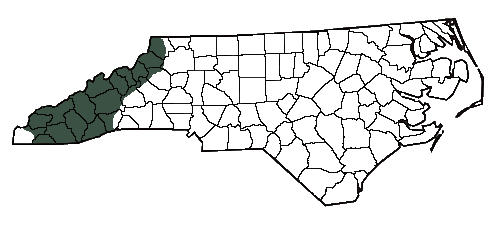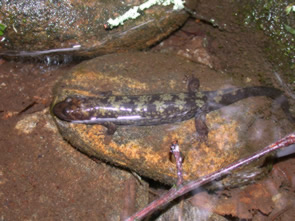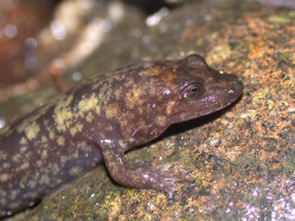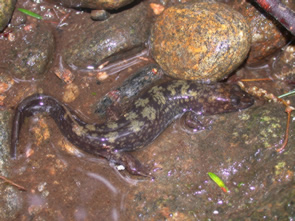-gmc-7-9-2008-Overflow Creek, Macon Co, NC.jpg)
Desmognathus marmoratus
Photo by Grant Connette
Description: The shovel-nosed salamander is nearly completely aquatic and has a laterally flattened, paddle-like tail. The head is flattened and is said to be shovel-shaped. These salamanders may range in color from gray to brown or black, typically with a dull mottled pattern on the back. Two rows of light spots may be found on the side of the body. This species is easily confused with the black-bellied salamander (Desmognathus quadramaculatus), yet black-bellied salamanders have less flattened heads, more prominent eyes, and a more conspicuous light line from the eye to the back of the jaw. The color of the belly does not always reliably distinguish between these two species.
Habitat/Range: In North Carolina, shovel-nosed salamanders occur primarily in cold, second and third order streams in the western part of the state. They are found primarily in fast moving streams, most frequently under large rocks in rapids and riffles. Although shovel-nosed salamanders often inhabit the same streams as black-bellied salamanders, this species tends to occupy the middle of the stream while black-bellied salamanders are generally found along the stream edge.
Diet: Shovel-nosed salamanders consume primarily aquatic invertebrates but will occasionally consume smaller salamanders.
Reproduction: Females lay eggs in small clusters on the undersides of large rocks in fast-flowing streams. Eggs hatch in 10-12 weeks and the emerging larvae possess external gills for up to 3 years. At the end of this larval stage, the salamander goes through metamorphosis and the gills are resorbed.
Miscellaneous: When discovered under a cover object, this species will often remain still or slowly and deliberately walk towards another cover object while black-bellied salamanders typically make a rapid escape attempt. This species has very specific habitat requirements and may disappear from a stream that experiences siltation, contamination by heavy metals, or a change in stream acidity.

The shaded region represents the range of the shovel-nosed salamander in North Carolina.

-gmc-7-9-2008-Overflow Creek, Macon Co, NC.jpg)

Photo by JD Willson
Notice the dark belly on this shovel-nosed salamander which may lead to confusion with the black-bellied salamander.
Photo
by Grant Connette
-gmc-7-9-2008-Overflow Creek, Macon Co, NC.jpg)

Photo by Grant Connette
Note the paddle-like tail of this highly aquatic salamander.
Photo by JD Willson
